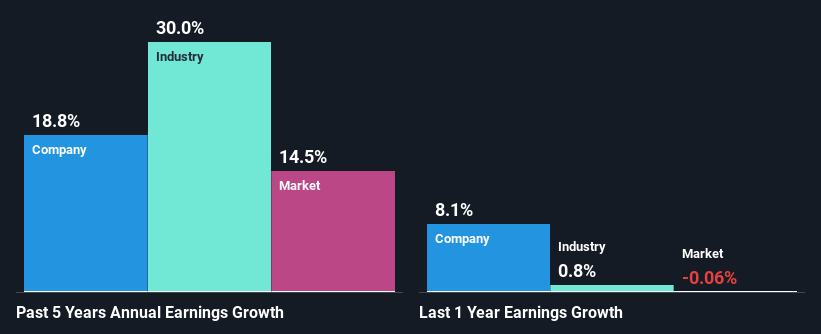Is Universal Display Corporation's (NASDAQ:OLED) Recent Stock Performance Tethered To Its Strong Fundamentals?
Universal Display (NASDAQ:OLED) has had a great run on the share market with its stock up by a significant 22% over the last month. Given the company's impressive performance, we decided to study its financial indicators more closely as a company's financial health over the long-term usually dictates market outcomes. In this article, we decided to focus on Universal Display's ROE.
Return on equity or ROE is an important factor to be considered by a shareholder because it tells them how effectively their capital is being reinvested. In short, ROE shows the profit each dollar generates with respect to its shareholder investments.
View our latest analysis for Universal Display
How Is ROE Calculated?
ROE can be calculated by using the formula:
Return on Equity = Net Profit (from continuing operations) ÷ Shareholders' Equity
So, based on the above formula, the ROE for Universal Display is:
15% = US$206m ÷ US$1.4b (Based on the trailing twelve months to September 2023).
The 'return' is the profit over the last twelve months. Another way to think of that is that for every $1 worth of equity, the company was able to earn $0.15 in profit.
Why Is ROE Important For Earnings Growth?
We have already established that ROE serves as an efficient profit-generating gauge for a company's future earnings. Depending on how much of these profits the company reinvests or "retains", and how effectively it does so, we are then able to assess a company’s earnings growth potential. Assuming all else is equal, companies that have both a higher return on equity and higher profit retention are usually the ones that have a higher growth rate when compared to companies that don't have the same features.
A Side By Side comparison of Universal Display's Earnings Growth And 15% ROE
At first glance, Universal Display seems to have a decent ROE. Even when compared to the industry average of 15% the company's ROE looks quite decent. This probably goes some way in explaining Universal Display's moderate 19% growth over the past five years amongst other factors.
As a next step, we compared Universal Display's net income growth with the industry and were disappointed to see that the company's growth is lower than the industry average growth of 30% in the same period.
The basis for attaching value to a company is, to a great extent, tied to its earnings growth. The investor should try to establish if the expected growth or decline in earnings, whichever the case may be, is priced in. This then helps them determine if the stock is placed for a bright or bleak future. If you're wondering about Universal Display's's valuation, check out this gauge of its price-to-earnings ratio, as compared to its industry.
Is Universal Display Efficiently Re-investing Its Profits?
Universal Display has a low three-year median payout ratio of 25%, meaning that the company retains the remaining 75% of its profits. This suggests that the management is reinvesting most of the profits to grow the business.
Moreover, Universal Display is determined to keep sharing its profits with shareholders which we infer from its long history of seven years of paying a dividend. Our latest analyst data shows that the future payout ratio of the company is expected to rise to 30% over the next three years. Regardless, the ROE is not expected to change much for the company despite the higher expected payout ratio.
Conclusion
In total, we are pretty happy with Universal Display's performance. In particular, it's great to see that the company is investing heavily into its business and along with a high rate of return, that has resulted in a respectable growth in its earnings. We also studied the latest analyst forecasts and found that the company's earnings growth is expected be similar to its current growth rate. Are these analysts expectations based on the broad expectations for the industry, or on the company's fundamentals? Click here to be taken to our analyst's forecasts page for the company.
Have feedback on this article? Concerned about the content? Get in touch with us directly. Alternatively, email editorial-team (at) simplywallst.com.
This article by Simply Wall St is general in nature. We provide commentary based on historical data and analyst forecasts only using an unbiased methodology and our articles are not intended to be financial advice. It does not constitute a recommendation to buy or sell any stock, and does not take account of your objectives, or your financial situation. We aim to bring you long-term focused analysis driven by fundamental data. Note that our analysis may not factor in the latest price-sensitive company announcements or qualitative material. Simply Wall St has no position in any stocks mentioned.

 Yahoo Finance
Yahoo Finance 
